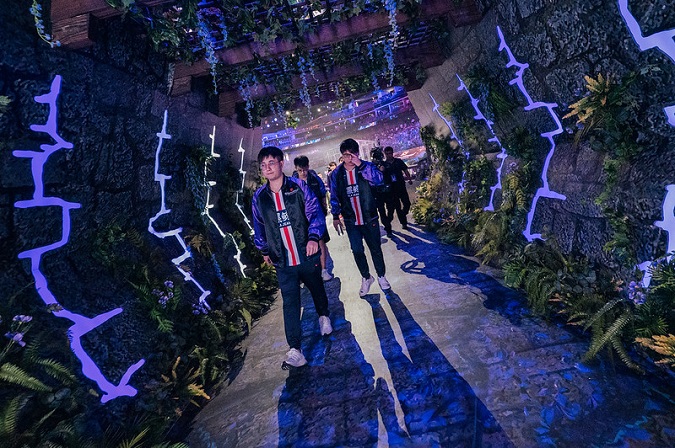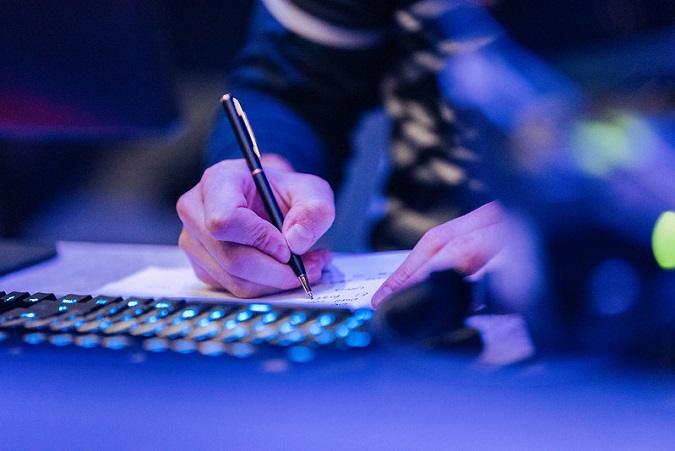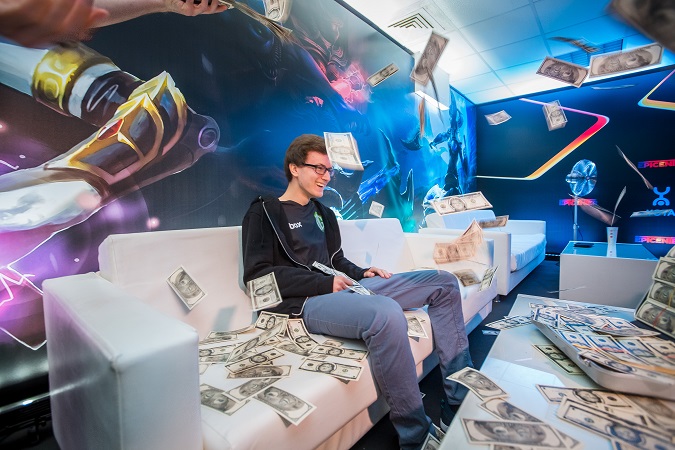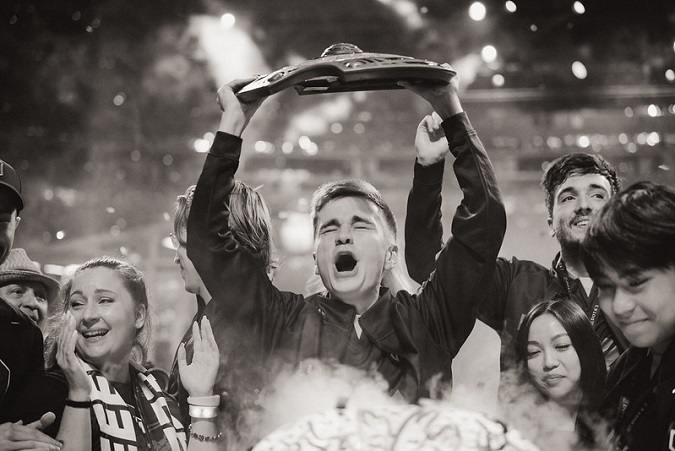A pipeline for amateurs or aspiring professionals to reach higher levels is essential. So what does Dota 2's look like?
Aspiring pros need to hustle, sacrifice, self promote and hope for a little luck. It's no easy feat but a roadmap or pipeline provides a clear trajectory that leads to a higher potential of success, attaining skills and achievements.
For years the Dota 2 pipeline was the Tier 2 scene which was thriving — filled with tournaments, opportunities for exposure, base salaries, boot camps —all of which eventually helped players became part of the elite. Cr1t, Yapzor, rodjer, solo, played for teams such as Balkan Bears, ProDota Gaming and RoX before being recruited to bigger and better teams.
Since the creation of the Dota Pro Circuit (DPC) system, the tier 2 scene has been quickly declining, each year worse than the previous one with those complaints outlined in an earlier exclusive feature for the site. The most prominent complaint? The lack of financial sustainability for the tier 2 teams and players, which then bleeds into the overall health and development of the scene as explained by Rasmus Johan “Chessie” Blomdin and Rafał "eL lisasH" Wójcik and explored previously in a GosuGamers editorial feature about the Tier 2 scene.
So what happens when the pipeline's gaping holes are repaired by independent third parties? A Frankenstein attempting to breathe life into an otherwise broken system? How sustainable is this patchwork job? What happens to the scene and players when the holes remain open? Where do they fall to and how far if they fail to jump the hurdle? What is the impact of Valve's hands-off approach and funneling money into only the top echelon of the scene?
Pipelines for player development

For years China seemed to be ahead of the curve when it came to an infrastructure that promoted and enabled aspiring players to become professionals. But even China's pipeline that had been a healthy conduit towards professional careers now seems to be eroding.
"Chinese esports is in many ways much more developed and deep-pocketed owners had been planning this sort of long term approach long ago (...) Their model has always been more 'mature' and more similar to the soccer model with big and small clubs, transfer fees, and different levels of competition,
Jack "KBBQ" Chen, Chaos esports club team manager and long-time Chinese guru for the West, told GosuGamers recently. There were academy teams, leagues and there always seemed to be a way for young and new players to reach higher levels.
Academy Teams
“What's in a name? that which we call a rose. By any other name would smell as sweet.”
Youth club. Nursery club. Farmer system. Feeder team. Farm teams.
No, we are not referring to the Farming Simulator League here, though it is boasting a 14 tournament circuit around Europe until summer 2020 with a 250,000€ prize pool and sponsors such as John Deere and Trelleborg sponsoring them. And we are also not referring to the group of feeders from your pub games.
We are talking about the Academy Teams. A system whose role is to provide experience and training to younger players with an agreement if successful can move on to a higher level at a given point.
Usually, in association with traditional sports, it is not uncommon in other esports divisions outside of Dota 2.
In 2017 Riot Games created a program called Scouting Grounds in order to identify new talent for the League Championship Series (LCS). Top players from amateur online play to compete in front of LCS staff. Twenty players are flown out to meet coaches and analysts as they form four teams which will then compete against each other, giving the staff a chance to observe, listening in on the communication before, after and during matches, to watch and analyze the teamwork and individual skill and personalities and to conduct interviews. Players that are seen as professional material are then recruited. Every LCS team has an academy based counterpart. The academy takes players with a high level of mechanical skill and teaches them the other soft skills needed to succeed in competitions.
Prior to and even now despite's Valve's newer rule about multi-team ownership being unable to field two teams competing at The International, Chinese organizations have often had academy or youth teams. Many times the multiple teams are housed in one space.
"It is extremely effective to create your own pipeline and put everything under one roof as big esports organizations are doing.
Chen continues to explain his statement.
"To give an example ViCi Gaming has a large sports 'campus' in shanghai, in it they can house multiple main and secondary teams, put all the coaches and staff and media/management/promotion cheaply under one roof, acquire youth players' contracts and rights when they are young and still looking for basic support to pursue their dreams. Then once some of these young players grow, their contracts are already owned by the big org so they can be sold for huge fees or promoted cheaply (whereas buying or acquiring talent from another organization in the current environment would be way more expensive). "
He points out LGD and ViCi Gaming as prime examples of Chinese teams that have had the most success recently and are following this strategy.
"LGD has had a ton of youth teams for a while and still do, so does VICi, and the bulk of their current top players come from their 'farm system'.
For LGD it's ame and maybe from CDEC, chalice was bought from another organization, xnova from SEA (where they want to keep establishing LGD.int for a direct pipeline but they've been ahead of the curve in getting SEA players, ah fu being another example).
For ViCi, yang, pyw, fade (last season) dy all spent time in their youth system."
But it's not as easy as to just set up a full campus or start academy teams nowadays. There are many factors including financial obstacles and player priorities. That means if you don't already have the structure in place, it is probably not going to happen.
But China also seems to be getting hit with the realization that esports isn't very profitable at this stage, especially in Dota 2. All of the issues with The International prize pool driving the majority of the prize money to be earned becomes an even bigger issue in China where the teams also compete against streaming platforms where players make a big bulk of their money. In order to entice players to leave a lucrative stream where they also have more freedoms in schedule and work for themselves, the contracts end up very lopsided. Chinese orgs aren't willing to pay high buyouts (anymore) and it's already hard enough to profit off of the main team.
And if China is starting to feel the pinch what does that mean for other regions? To begin with, this model is not one that can even be applied elsewhere according to Chen.
"I don't think every region is prepared for that sort of approach. It doesn't make much sense in say, NA with its small player base and much higher costs for infrastructure and support. In NA you're now seeing that even some high-level stacks and teams have a hard time getting any sort of consistent support. Structurally it makes sense but the incentives aren't always there and we know Valve is pretty hands-off with this sorta thing."
Other regions have and are still trying. It's been a valiant effort at least.
The CIS region has had a handful of teams and still does currently as we see Empire.Hope, and Pavaga Gaming Junior competing in smaller online cups and the open qualifiers for the DPC.
OG began a new project just last month aptly named OG Seeds. The project aims to "become an efficient contribution" to the Dota 2 ecosystem by creating a team of players that they strongly believe in but haven't reached their ultimate achievements yet.
Former coach and two TI winning offlane player Sébatien "Ceb" Debs stated on the OG Website :
“This OG Seed journey comes with great expectations for us at OG. Being able to go back in time, alongside up and coming players, is simply amazing. I know this is going to be a win-win situation for everyone involved. We will share experience, maturity and knowledge, while they will feed us with their immense motivation, their drive and passion. We intend to give them the best we can offer and help them achieve their dreams just like we achieved ours. Hopefully you’ll enjoy the ride as much as we will. Cheers OGs, love ya” – Ceb
Last year OG was one of the top-grossing teams in the world of esports. At The International 2019 they walked away with around $15.6 million alone and rounded out the year with a whopping $33,436,766 total.
For.one.year.
They clearly have the deep(er) pockets to be able to financially contribute and invest their own money into creating opportunities for others, not to mention the clout and prestige that sponsors will all (and already) clamor to. The biggest question tho remains what will the fate of the seed team be with Valve's one team rule at TI as OG still intends to compete this year? Sources indicate to GosuGamers that the players were given two-year contracts with OG, which leads one to believe that a buyout will need to be negotiated for each of the players or the team as a whole after they are groomed for greatness. That could be quite a hefty price-tag and sometimes too great of one, as in the case with Syed Sumail "Suma1L" Hassan who, sources say, is still negotiating regarding contract terms with Evil Geniuses.
Leagues and Divisions
Academy Teams aren't the only way to path for players to move along the ranks into higher endeavors.
Overwatch has open tournaments where players work way up to contenders division. From there, players can make the last step to Overwatch League (OWL). Nine out of 12 OWL teams have a corresponding academy in contender divisions and Blizzard has contributed more than $13million in prize money to players for their individual victories.
In CS:GO, ESL and ESEA (eSports Entertainment Association League) have partnered up to create a league where aspiring pros get to prove themselves. Players pay $8.99 a month each to receive access to the platform which gives consistent high skill matchmaking and the anti-cheat software.
For Dota 2 some of the biggest success stories in China were born in the CDEC Inhouse league - Maybe, all of CDEC, even parts of Wings were all recognized and found there. But the inhouse league died out and players focus more on pubs now, possibly for the same reason inhouse leagues died in the west.
The "West". There was a brief point in 2015 when Jonathan "Loda" Berg and Gleb "Funn1k" Lipatnikov announced their collaboration with FACEIT for the FACEIT Pro League in the EU/CIS regions. Top players from the scene were invited to play while up and coming players had a chance to qualify for an invite through the FACEIT ladder system. It never really seemed to take off. NADCL was NA's hope for revitalizing the scene and fostering talent last year. Unfortunately, it lasted only 3 seasons and stopped due to funding and finding sponsors, a small player base and getting viewers to watch tier 2/tier 3 games is difficult. Last year Peter "ppd" Dager reported to Maincast in an interview in Split, Croatia that they had trouble finding funding sources for it and the first three seasons were paid for out his own pocket.
It becomes a challenge to find new talent without the inhouse leagues though. It is much more difficult to find real talent in a pub setting because the environment is a false one, very different from that of a competitive official or scrimmage match. Now, it becomes a matter of grinding up MMR ladder which doesn't necessarily indicate all of the soft skills needed to be a good teammate or even mechanical skill at times.
But MMR is just a number right? The importance of rank on the ladder seems to be growing while wading through the waters for the wins seems to be getting harder and harder.
In October 2019, Dotabuff and ESL partnered up to create Reach - a new platform that Sabina Hemmi, CEO and Co-Founder of Elo has told GosuGamers aims to help aspiring players reach their dreams of becoming professionals and give them the tools and resources necessary to actualize it.
According to the announcement made in October 2019
"For the past year the teams at Dotabuff and ESL have been working closely together to bring you a new way to compete and gain recognition in the chaotic world of professional Dota. Today we proudly announce Reach—a platform where players can experience the highest level of play, win big prizes and get noticed by organizations to further their career."
The ESL Academy will attempt to provide the next step, offering top players on the Reach ladder an opportunity to network with professional players and the opportunity to be scouted by professional teams.
The ESL Academy system’s goal is to develop, promote, and elevate undiscovered Dota 2 talent on the verge of going pro.
Financial stability is only one obstacle between players and the world of high-profile professional Dota. That is where the ESL Academy program comes in. The top 40 players of each season will be eligible to be drafted into an unparalleled experience at ESL One Dota event, where they will get LAN experience, help from professional coaches and networking opportunities with Dota pros. Once you are at the top of any ladder, the only thing holding you back is a lack of recognition and ESL Academy can help you make that final step.
Reach and ESL Academy are still in the infancy stages and moved out of beta testing just a few weeks ago.
Colleges and courses

The NFL is only one of the four major sports leagues in the US to not to have a farm but instead, a draft which is nearly all from the NCAA (national collegiate athletic associations). In these instances, the colleges and universities provide the room and board, the coaching and training all in accordance with the standards and regulations to become a professional player. It used to be the same for the NBA, but during the last fifteen or so years basketball switch to a league system similar to that of the MLB.
In 2017 Asia Pacific University (APU) alongside eSports Malaysia (ESM) organized an esports Academy to develop professional gamers – the first in the country. These games will be Dota 2, League of Legends, Counter-Strike and FIFA Online. Graduates earn certificates in Skill for each of the games. The courses focus on raising professional gamers but eventually, other parts of the esports industry are hoped to be added into the mix such as team managerial skills and even shout-caster training.
Sweden, a hub for esports, specifically in the Dota 2 world and now also France also have their own courses and schools. There are five public and private ones in France alone that focus on various aspects of gaming and typically one year in length to complete.
While some of the basics such as management, teamwork, leadership, and communication can be taught and are extremely helpful, without any standardization or real accreditation, what does a certificate even mean and to who? At that point just going '1v1 mid' might be a more reliable and credible proof of domination.
Show me the money

Image courtesy of EPICENTER
Skill building is time-consuming and expensive. Players can spend months to years in the pipeline honing skills and techniques needed to move from an amateur to a professional. Not only do the players (and all of the coaches and ancillary staff) need to be able to supported in training but also through the living and daily expenses.
Whether it is an academy team, a league or division or courses, someone needs to pay for all of this.
Sponsorships (or lack of)
Unlike minor league or college sports, it would be near impossible to fill a court/arena with fans to watch Tier 2 or Tier 3 teams competing at LAN. Ticket sales would be hard-pressed to cover the costs associated. It would barely attract any international level sponsors and local sponsorships would barely scratch the surface for providing enough funds to run an event. It certainly wouldn't be profitable.
Typically in esports, the funding for organizations and teams comes primarily from the sponsors as marketing and advertising funds. The prize pools are primarily funneled to the players with usually only 10-12% going to the organization. That percentage won't pay the bills and salaries unless it is from a premier LAN event and the team is taking home top placements.
During the last two years, several CEOs and team managers of organizations in EU and NA have confided to GosuGamers that they have dropped their Dota 2 divisions as it became increasingly difficult to turn a profit on them. Sponsorships became harder and harder to come by while salaries and costs continued to rise. Opportunities for teams under the Tier 1 scene have become more and more obsolete as online tournaments have begun to fade out and in especially these two regions, the giants continue to claim all the space for LAN and DPC events. Getting to TI is a near impossibility too for these regions.
TI doesn't automate success. You get the exposure, but how do you monetize it if no sponsor cares about Dota?
Yet there is a discrepancy between Valve's two top games Dota 2 and CS:GO. Despite the jaw-dropping prize pool of The International each year, CS:GO is still more attractive and sustainable when it comes to investments. This year alone, several new organizations including GenG, 100T, OG, EG picked up CS:GO teams while other divisions are getting dropped daily, especially Dota . It's partly because CS:GO has a sustainable business model coming up with leagues and possible franchises. That allows teams to be confident to commit to the game with their own money and means an aspiring player can now play competitively and live in a team house. This is something that just doesn't exist in Dota. The lower tier players must also make a living off of other day or night jobs, streaming or still living at home.
Many of the big non-edemic sponsors such as AT&T, Comcast, Telekom, HTC don't really care specifically about Dota or The International. It's a one-off event that doesn't get them anything in the long term. With a large majority of the English speaking fan base being located in the SEA region, it is also not a market that is lucrative nor attractive to international sponsors. Purchasing power in the west belongs to League, Fortnite and CS:GO.
One source told GosuGamers:
"Dota salaries and costs outgrew what sponsors are willing to pay for Dota exposure. There are brands interested in working within Dota, and there always will be, but there used to be times when one sponsor could cover the entire cost of the team, or even two. Now you need 5 sponsors to cover that, especially a team with managers and coaches."
Ask prominent Dota 2 statistician and personality Alan “Nahaz” Bester on any given day about the ecosystem and infrastructure of Dota 2. It's guaranteed to light up his day and you're bound to spend hours listening to the economic climate and problems that have come into being with the introduction of the DPC.
Bottom line
Will Partin, a well-established researcher and consultant for esports, has proclaimed a very eye-opening take last year: The International Is Bad For Dota 2. His stance is it comes down to Valve to step in to change the future state of the game for players to be able to continue to enter into the playing field and prosper.
"On its current trajectory, the only real winners in Dota 2 are a handful of elite teams and Valve. Everyone else—tournaments, teams, and all but a few players—has to fight for scraps, or leave. But another Dota 2 is possible, and it is largely up to Valve, which could regulate this ecosystem if it chose to. This is the bitter irony of Valve, a company that makes a big deal about its “hands off” approach to esports compared to Blizzard and Riot, yet is nevertheless the center of the Dota 2 scene thanks to The International. (...)
Altering The International in these ways would, in all likelihood, take some of the luster off of the tournament and ask sacrifices of Valve, whether in the form of tempered (short-term) profits or an expense of labor. But it would set the game up for long-term success. In its current form, The International is an antagonist to the best version of Dota 2’s future, the one that supports the most players possible, building the quality of competition for years to come. "
Unless Valve starts putting their hands in their pockets the pipeline may never adequately be repaired or functional. Third-party organizations like REACH won't be able to sustain the entire infrastructure on their own and OG can't nurture an entire scene themselves - unless they win another The International, which of course, is entirely possible we suppose.


